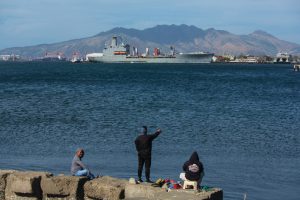BLOOMBERG
It’s been more than three decades since the Philippines ordered US troops to withdraw from their sprawling military bases in the country, ending an era that hearkened back to America’s colonial days.
Now the man overseeing the Subic Bay Metropolitan Authority — once home to the US’s biggest naval base in Asia — wants them back.
A recently revived defense agreement between the US and the Philippines could “be a welcome development for us†if American forces return to Subic Bay, said Rolen Paulino, the authority’s chairman, in an interview. “When they come here they spend money, go to hotels, go to restaurants — plus tourists.â€
Paulino isn’t alone. Beyond the local economic benefits, the Philippines’ strategic location means that a renewed US presence would be a huge asset to Washington in case of a conflict over Taiwan.
In contrast to earlier decades, when the US-Philippine alliance was seen as skewed toward Washington, now Manila has security concerns of its own.
President Ferdinand Marcos Jr.’s government is looking to counter a record number of Chinese incursions in the disputed South China Sea that have seen Filipino fishing ships harassed or driven away from traditional waters. Public outcry erupted last month when a Chinese coast guard vessel aimed a laser at a Philippine ship.
Marcos was blunt in telling the armed forces this week that their mission has changed, and put US-China tensions as the reason why.
“There was a time where we did not have to worry about these threats and the intensification of the competition between the superpowers,†Marcos said on February 27. “Now things have begun to change and we must adjust accordingly.â€
So far, public sentiment appears to be on the side of stronger US ties.
In a survey published on February 9 by the Asean Studies Centre at the Iseas-Yusof Ishak Institute in Singapore, nearly 79% of Filipinos said if Southeast Asia were forced to choose between the US and China, they would choose the former.
Marcos isn’t just looking for US support: he’s turning to regional allies as well. He said he’d be open to a reciprocal military access agreement with Japan if it would protect the country’s fishermen and its maritime territory, and last month the Philippines said it’s considering joint patrols with Australia.
“The Philippines straddles a crucial location in the Pacific, and we have seaboards to the north, south, east and west,†Defense Secretary Carlito Galvez Jr. said in a statement. “All of these must be monitored and protected.â€
But while US-China tensions are driving the rapprochement, America’s complicated past with the Philippines, and fears that embracing Washington will drag Manila into any future conflict with China, are giving some communities pause.
“They are not welcome,†said Manuel Mamba, governor of Cagayan province, which hosts one of the facilities US troops might soon have access to. “China has been good to us. I don’t see any threat coming from them and my province is one of the nearest to them.â€
That kind of pushback may be why US Defense Secretary Lloyd Austin and Galvez stopped short of disclosing where US troops would be working when they agreed last month to expand the Enhanced Defense Cooperation Agreement. That’s a 2014 accord that was shelved under former President Rodrigo Duterte.
 The Gulf Time Newspaper One of the finest business newspapers in the UAE brought to you by our professional writers and editors.
The Gulf Time Newspaper One of the finest business newspapers in the UAE brought to you by our professional writers and editors.
